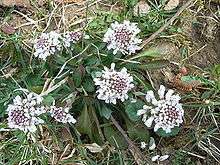Thlaspi caerulescens
| Thlaspi caerulescens | |
|---|---|
 | |
| Scientific classification | |
| Kingdom: | Plantae |
| (unranked): | Angiosperms |
| (unranked): | Eudicots |
| (unranked): | Rosids |
| Order: | Brassicales |
| Family: | Brassicaceae |
| Genus: | Thlaspi |
| Species: | T. caerulescens |
| Binomial name | |
| Thlaspi caerulescens J.Presl & C.Presl | |
| Synonyms | |
|
Thlaspi alpestre L. | |
Thlaspi caerulescens, Alpine Penny-cress[1] and also known as alpine pennygrass, is a flowering plant in the family Brassicaceae. It is found in Scandinavia and Europe.
Description
Thlaspi caerulescens is a low biennial or perennial plant that has small basal rosettes of stalked elliptic–lanceolate leaves with entire margins. The one or more flowering stems have small stalkless, alternate leaves clasping the stem. The inflorescence is a dense raceme which continues to lengthen after flowering. The individual flowers are regular, with white or pinkish petals and are about 5 mm (0.2 in) wide. Each has four sepals, four petals, six stamens (four long and two short) with violet anthers, and a single carpel. The fruit is many-seeded and narrowly spatulate and has a notched tip. This plant flowers in late spring.[2]
Distribution and habitat
In Europe it is found in Finland and Sweden, in all but the most northerly regions. It is also found in the Alps, the Massif Central, the Pyrenees, eastern Norway, southern Germany, and northern England.[3] It is a plant of dry hillside meadows, forest margins, banks, gardens, lawns, pastures, field margins, yards and bare places.[2]
Phytoremediation
In addition to being just a wildflower, alpine pennycress has been cited in phytoremediation to have special phytoextractional properties and is known to absorb cadmium with very good results and in certain instances is said to have absorbed zinc as well.[4]
References
- ↑ "BSBI List 2007" (xls). Botanical Society of Britain and Ireland. Retrieved 2014-10-17.
- 1 2 "Alpine Pennycress". NatureGate. Retrieved 2013-12-24.
- ↑ "Backskärvfrö". Den virtuella flora. Naturhistoriska riksmuseet. 25 October 2004. Retrieved 30 August 2010.
- ↑ Comis, D. (2000). "Phytoremediation: using plants to clean up soils". Agricultural Research. Retrieved 4 March 2006.